Molar Mass
Multi-Angle static Light Scattering (MALS) measures molar mass directly, in solution. Combined with a fractionation technique like SEC or FFF, MALS determines absolute molar mass distributions - independent of elution time.
How To Determine Molecular Weight
While there are many ways to determine the molar masses, or molecular weights, of macromolecules such as proteins, biopolymers and synthetic polymers, only one determines absolute molecular weights in solution, rapidly and effectively: Multi-Angle Light Scattering (MALS). MALS combines the precise measurements of light scattering intensity and concentrations for a rigorous, first-principles calculation of solution-property molecular weights—making no assumptions of conformation or shape, and no perturbations to the sample. The theory of multi-angle light scattering for the determination of molecular masses is described in detail in Classical Light Scattering Theory.
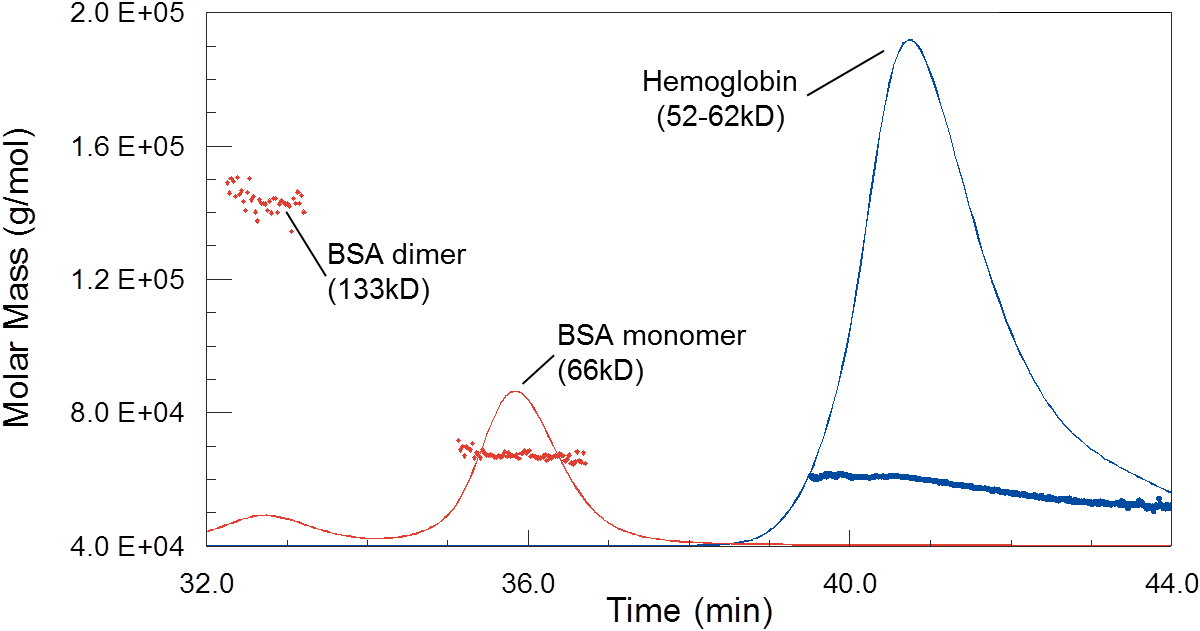
While column calibration would suggest that hemoglobin is much smaller than BSA, MALS shows that they do in fact have similar molar masses. The polydispersity of hemoglobin, seen here as a trailing shoulder on the peak with decreasing molecular weight, is due to dynamic equilibrium between monomers, dimers and tetramers.
On-line (fractionated) MALS
MALS detectors are most commonly integrated with a separation technique such as size exclusion chromatography (SEC-MALS) or field-flow fractionation (FFF-MALS). Incorporation of independent, absolute MALS analysis eliminates reliance on unreliable column calibration, retention time and models of hydrodynamic size vs. molar mass in order to provide accurate molar mass distributions across the chromatogram or fractogram.
Important Applications of SEC-MALS and FFF-MALS
- Molar mass distributions of heterogeneous samples such as carbohydrates or synthetic polymers
- Accurate aggregation and oligomeric states of proteins, peptides and virus-like particles (VLPs)
- Stoichiometry of tightly bound protein heterocomplexes
See the SEC-MALS and FFF-MALS pages to learn how these versatile techniques combine multiple detectors, including the DAWN™, miniDAWN™ or microDAWN™ MALS detectors and the Optilab™ or microOptilab™ refractive index concentration detectors, with the ASTRA™ software in order to extract a wealth of information about your samples beyond molar mass.
Batch MALS
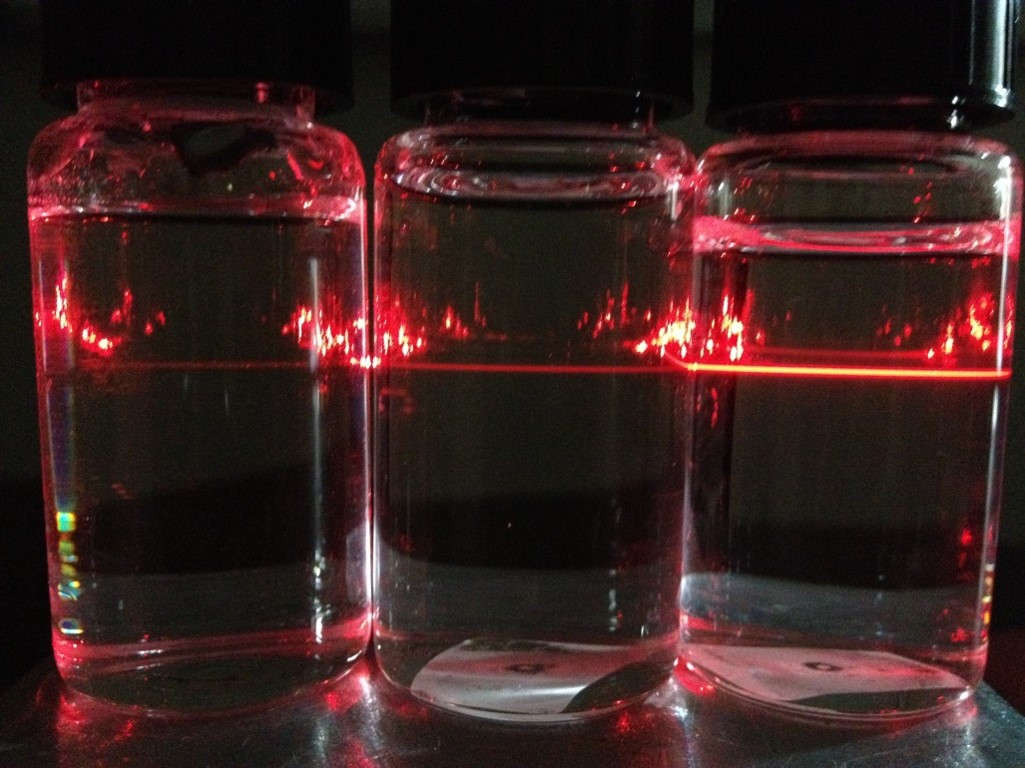
Even if samples are not compatible with a separation technique, MALS can still be used to perform analysis of molar mass. Analysis of unfractionated samples yields the weight-average molecular weight Mw of the solution, as well as the second virial coefficient A2 (a.k.a. B22), a measure of solute-solute interactions.
These unfractionated, or 'batch', measurements are typically carried out via direct injection into a MALS flow cell. For maximum accuracy the measurement is carried out over several concentrations. Historically, batch measurements have been laborious and prone to operator error; the Calypso™ automates batch MALS for accurate, reliable and rapid results.
When use of a flow cell is undesirable, Wyatt offers a microCuvette™ Adapter Kit which replaces the flow cell of a DAWN with a high-quality, low-volume microcuvette. Alternatively, the DynaPro™ NanoStar™ and DynaPro™ ZetaStar™ offer true static light scattering (SLS) analysis of molar mass for molecules < 50 nm in radius.
Batch MALS is also useful as an orthogonal technique to validate SEC-MALS results against potential loss of sample on the column as well as dissociation of aggregates due to shear or dilution.
Molar Mass via Dynamic Light Scattering (DLS)
Strictly speaking, DLS measures the diffusion constant of particles in solution and cannot determine molar mass directly and rigorously. DLS analysis estimates molar mass in the DYNAMICS™ software by converting the diffusion constant to an effective size and invoking models that assume relationships between size and mass. See DLS Theory for more details.
While less rigorous than MALS for precise molar masses, DLS is effective as a rapid, low-volume screen for aggregation and other shifts in solution properties. Sample volumes as small as 1.25 µL may be analyzed in the DynaPro NanoStar, while the DynaPro™ Plate Reader offers high-throughput measurements in industry-standard microwell plates.
Molar Mass via Intrinsic Viscosity
Intrinsic viscosity and 'Universal Calibration' are commonly used to determine molecular weights of synthetic polymers. Though these techniques are less rigorous than MALS, they may be the optimal means of characterizing materials not amenable to MALS analysis:
- When the solvent and solute have the same refractive indices (making dn/dc=0), the polymer does not scatter light
- When the polymers fluoresce under excitation by the MALS laser, the fluorescence greatly increases the apparent scattering signal producing erroneous molecular weights. While a fluorescence blocking filter may be incorporated into the DAWN, this does not always provide a sufficient solution to strongly fluorescing polymers.
The ViscoStar™ differential viscometer coupled with an Optilab differential refractometer to any GPC system provides superior measurements of intrinsic viscosity for characterization of all types of polymers. Estimates of molar masses based on intrinsic viscosity and the Mark-Houwink equation η=KMα rely on empirical values of K and α established in the literature, while Universal Calibration is valid for all random coil polymers assuming no non-ideal column interactions.
The ASTRA software not only analyzes polymers based on the Mark-Houwink equation and Universal Calibration technique, but may also be used to establish Mark-Houwink coefficients using light scattering to determine molar masses ab initio.
Process MALS
In addition to standard analytical applications of MALS, it may be used to develop, monitor and control manufacturing processes, directly in the pilot plant or on the manufacturing floor. The ultraDAWN™ along with OBSERVER™ software determine and report the weight-average molar mass of protein or polymer solutions passing through the instrument in real time; this is known as RT-MALS.
Resources
Selected References
Folta-Stogniew, E. J. Macromolecular Interactions: Light Scattering. In Encyclopedia of Life Sciences; Wiley: 2001.
Lu, D.; Jimenez, X.; Zhang, H.; Atkins, A.; Brennan, L.; Balderes, P.; Bohlen, P.; Witte, L.; Zhu, Z. Di-diabody: a novel tetravalent bispecific antibody molecule by design. J. Immunol. Methods 2003, 279, 219-232.
Mogridge, J. Using light scattering to determine the stoichiometry of protein complexes. In Protein-Protein Interactions: Methods in Molecular Biology; Fu, H., Ed.; Humana Press: New York, 2004; Vol. 261, p 113-118.
<Sondermann, H.; Zhao, C.; Bar-Sagi, D. Analysis of Ras:RasGEF interactions by phage display and static multi-angle light scattering. Methods 2005, 37, 197-202.
Waters, J.; Leiske, D. Characterization of hyaluronic acid with on-line differential viscometry, multi-angle light scattering, and differential refractometry. LCGC 2005, 23, 302-310.
Instrumentation for Molar Mass
MALS Detectors
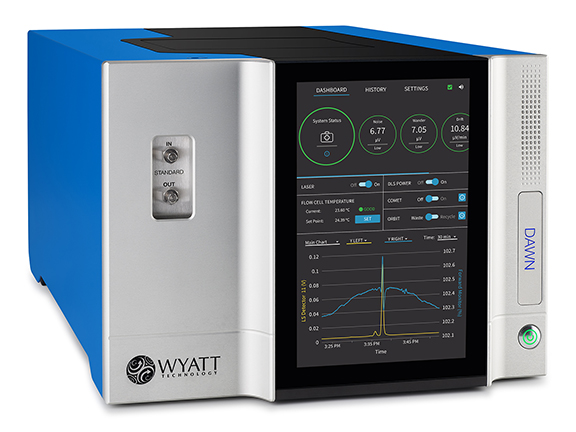
DAWN™ - The most sensitive MALS detector available, anywhere. Incorporates detectors at 18 angles to determine molar masses from 200 Da to 1 GDa and radii from 10 – 500 nm.
- Standard option: ambient temperature
- Heated/cooled option: -15 °C to +150 °C
- High-temperature option: ambient to +210 °C
The DAWN offers special options to handle fluorescent samples: fluorescence-blocking filters and an infrared, 785 nm laser.
miniDAWN™ - Second only to the DAWN in sensitivity. Incorporates detectors at 3 angles to determine molar masses from 200 Da to 10 MDa and radii from 10 – 50 nm. Ambient only.
microDAWN™ - The first MALS detector for UHPLC, with interdetector dispersion as low as 1.5 µL. Incorporates detectors at 3 angles to determine molar masses from 200 Da to 20 MDa and radii from 10 – 50 nm. Ambient only.
Refractive Index Detectors
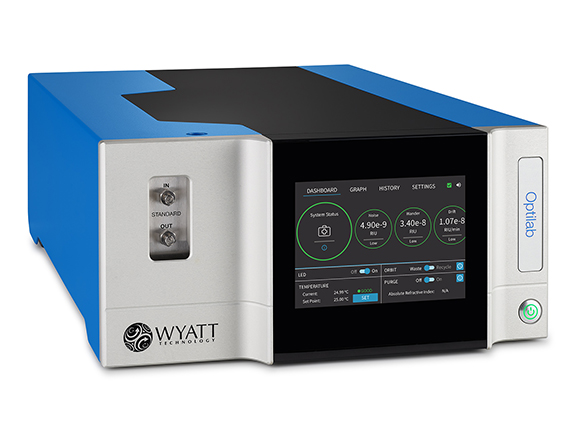
Optilab™ - A unique on-line differential refractometer for measuring concentration of any macromolecule, regardless of chromophores. Temperature controlled from 4 °C to 65 °C. The high-concentration option accommodates protein concentration up to 180 mg/mL.
microOptilab™ - The first RI detector specifically designed for use with all UHPLC systems.
Viscometer
ViscoStar™ - A highly sensitive, on-line differential viscometer used in conjunction with SEC-MALS to determine the size and conformation of all types of biopolymers, synthetic polymers and even proteins and peptides.
The ViscoStar incorporates multiple novel technologies to provide the highest sensitivity, stability and solvent compatibility of any available viscometer for GPC. Its ease-of-use and serviceability make it the perfect companion for Wyatt's DAWN light scattering and Optilab refractive index detectors. Temperature-controlled from 4 °C to 70 °C .
microViscoStar™ - Similar to the ViscoStar but designed specifically for use with UHPLC/APC.
Field-Flow Fractionation Systems

Field-flow fractionation performs versatile separations of macromolecules and nanoparticles ranging from 1 to 1000 nm in diameter and beyond. FFF-MALS-DLS is the ideal means for obtaining distributions of molar mass and size, nanoparticle concentration and extended characterization of conformation and conjugate content.
Eclipse™ - An FFF instrument offering superior performance, reliability and user experience. Supports the Dilution Control Module for enhanced sensitivity, and the SEC switching option for sharing the system between FFF and SEC separation modes.
Mobility EAF4 system - An add-on to an Eclipse which performs electrical/asymmetrical-flow FFF for determining charge and zeta potential distributions.
Eclipse Channels - The Eclipse offers a wide selection of separation channels and membranes to accommodate a variety of analytical and even semi-preparative tasks.
Instruments for Batch Measurements
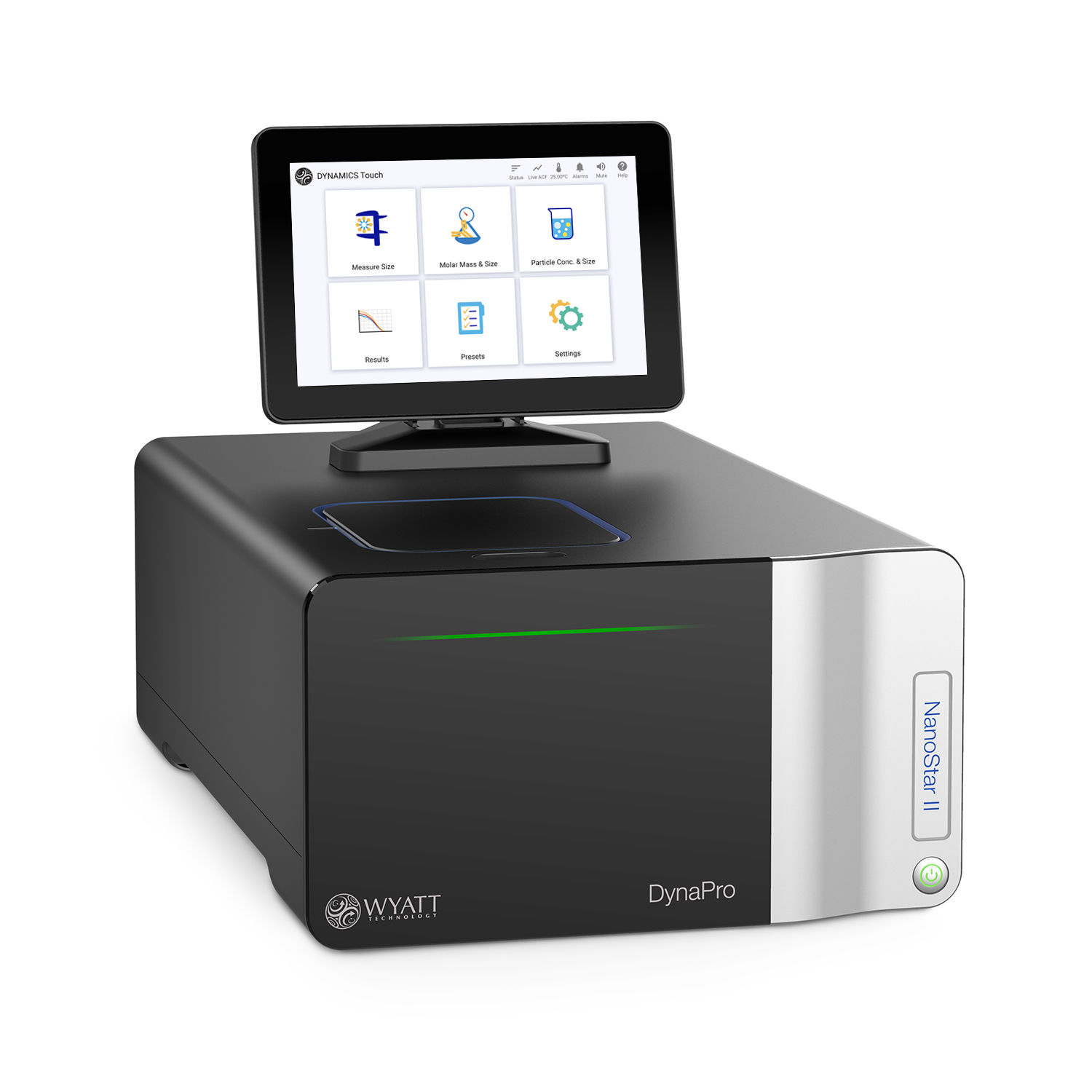
DynaPro™ Plate Reader - The only commercially available instrument that measures DLS and SLS, for size and molar mass, directly in situ in standard 96, 384 or 1536 microwell plates. The non-perturbing DynaPro Plate Reader offers integration with robot liquid handlers and multi-technique plate-based assay protocols. Temperature-controlled over 4 °C to 85 °C.
DynaPro™ ZetaStar™ - The only Wyatt instrument capable of measuring ELS, DLS, and SLS for walk-up or automated measurements of size, particle concentration, and zeta potential. For DLS and SLS measurements, the ZetaStar can measure with as little as 2µL and over a temperature range of -10 °C to + 120 °C. It offers a dedicated static light scattering detector in parallel to the DLS detection system in order to determine true molar mass.
DynaPro™ NanoStar™ - With sample volumes as small as 2 µL and temperature control spanning -10 °C to +120 °C, the NanoStar goes above and beyond traditional cuvette-based DLS instruments. It offers an optimized static light scattering detector in parallel to the DLS detection system in order to determine true molar mass.
Calypso™ - Preparative and sample delivery system for carrying out and analyzing automated batch (unfractionated) MALS in a DAWN or miniDAWN.
microCuvette™ - Allows static and dynamic light scattering measurements to be made simultaneously in a DAWN detector using a quartz cuvette, requiring only 10 µL.
Microbatch Kit - Used to inject samples into the flow cell of a MALS detector, and in determining dn/dc.
Software
ASTRA™ - Our comprehensive software solution for MALS and DLS analysis in chromatography, FFF or batch mode. ASTRA is available in a 21 CFR Part 11 compliant version and offers additional options such as particle analysis.
DYNAMICS™ - Software for batch DLS measurements in the DynaPro and Mobius™ instruments, as well as molar mass and A2 in the NanoStar and DynaPro Plate Reader and electrophoretic mobility in the Mobius. Calculates size and size distributions, and derives parameters such as the melting temperature Tm, the aggregation onset temperature Tagg and the diffusion interaction parameter kD. DYNAMICS is available in standard and 21 CFR Part 11 compliant versions.
CALYPSO™ - The CALYPSO software controls the Calypso composition gradient system and a MALS detector to measure solution weight-average molecular weight as a function of concentration or buffer conditions. These measurements are further analyzed by the CALYPSO software to determine binding constants, absolute stoichiometry and other parameters of macromolecular interactions.
VISION™ - Controls the Eclipse Field-Flow Fractionation (FFF) system. Coupled with ASTRA for data collection and analysis, VISION provides users with a turn-key solution for macromolecular characterization. VISION is available in a 21 CFR Part 11 compliant version.